Others - Classical antiquity - Sold antiquities
Archive of sold antiquities
All artefacts sold in our gallery are fully documented in our online archive and database. Being a specialist ancient art dealer, preserving also the more recent history of each and every piece sold in our shop is at our heart. That is particularly useful for artefacts that changed owners in the meantime. Information that may have been lost in the process can be easily restored from our archives. Please do not hesitate to contact us if you need further information about ancient items that have been sold in our gallery. We can help you with reconstructing the history of ownership for those items. All information about our customers will be kept confidential, of course.-
 Roman Celtic seal box
Roman Celtic seal boxLozenge shaped body with lid in Celtic design. A piece from the 1st or 2nd century, found near the Celtic settlement and later Roman town of Lindum. Published in a standard work by Richard Hattatt.
Price: on request Roman seal box
Roman seal boxPiriform body with engraved cross on the lid. A piece from the Roman Imperial period. Published in a standard work by Richard Hattatt.
Price: on request Roman seal box
Roman seal boxPiriform body with engraved bird on the lid. A piece from the Roman Imperial period, found near Dover. Published in a standard work by Richard Hattatt.
Price: on request Roman seal box with phallus
Roman seal box with phallusCircular body with protective phallus in high relief on the lid. A piece from the Roman Imperial period, found in North East England. Published in a standard work by Richard Hattatt.
Price: on request Four Roman bronze artefacts from Novaesium
Four Roman bronze artefacts from NovaesiumTwo handles, one of them beautifully incised. And one arrow head and an amulet. Finds from the Roman city of Novaesium, today's Neuss in Germany.
Price: on request Roman lock bolts from Novaesium
Roman lock bolts from NovaesiumPart of a key lock, e.g. for a door or chest. Finds from the Roman city of Novaesium, today's Neuss in Germany.
Price: on request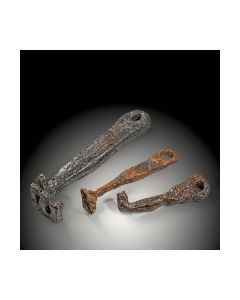 Three Roman iron keys from Novaesium
Three Roman iron keys from NovaesiumIron keys of typical shape. Finds from the Roman city of Novaesium, today's Neuss in Germany.
Price: on request Ancient ladle with donkey head terminal
Ancient ladle with donkey head terminalElegant long bronze ladle, from the Greek or Etruscan culture. 5th to 4th century BC.
Price: on request Egyptian coffin with snake
Egyptian coffin with snakeThe small bronze votive box is modelled on top with a coiled serpent. The artefact was probably made around 400 BC in Naukratis to be devoted to Atum.
Price: on request Roman bronze chain
Roman bronze chainFox tail type chain fragment. A Find from the Roman city of Novaesium, today's Neuss in Germany.
Price: on request Ancient ladle with bird head terminal
Ancient ladle with bird head terminalElegant long bronze ladle, from the Greek or Etruscan culture. 5th to 4th century BC.
Price: on request Base plate of a Roman mirror
Base plate of a Roman mirrorThe bronze disc is the base plate of a Roman mirror. A handle and reflective metal coating were once part of the mirror. Typical for upper class Roman households during Imperial times.
Price: on request Roman gaming pieces from the Rhineland
Roman gaming pieces from the Rhineland6 Roman glass gaming pieces and 8 other Roman artefacts. Finds from the Roman city of Novaesium, today's Neuss in Germany.
Price: on request Eight Roman bronze artifacts
Eight Roman bronze artifactsVarious artifacts in different states of preservation. Finds from the Roman city of Novaesium, today's Neuss in Germany.
Price: on request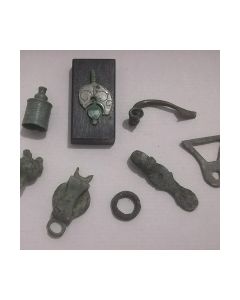 Eight Roman bronze artefacts
Eight Roman bronze artefactsVarious artefacts in different states of preservation. Finds from the Roman city of Novaesium, today's Neuss in Germany.
Price: on request Two Roman potsherds from the Rhineland
Two Roman potsherds from the RhinelandFragments of Roman pottery. Finds from the Roman city of Novaesium, today's Neuss in Germany.
Price: on request Jama-Coaque roller stamp
Jama-Coaque roller stampClay roller stamp with relief of plants to be applied as skin decoration. This tool was used in the early phase of the ecuadorian Jama-Coaque culture.
Price: on request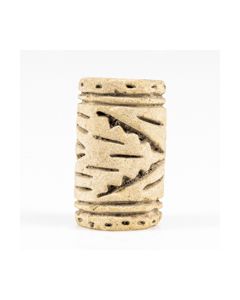 Jama-Coaque roller stamp
Jama-Coaque roller stampClay roller stamp with relief of stylized plants used to apply skin decoration. This tool is from the early phase of the ecuadorian Jama-Coaque culture.
Price: on request Egyptian mummy cartonnage
Egyptian mummy cartonnageCentral piece of a mummy cartonnage from the ptolemaic period. Covered with polychrome paint giving an interesting insight into ancient Egyptian funerary rituals. Probably originating from Akhmim in Upper Egypt.
Price: on request Egyptian mummy cartonnage from Thebes
Egyptian mummy cartonnage from ThebesChest and leg piece of a mummy cartonnage from the ptolemaic period. Covered with polychrome paintings giving an interesting insight into ancient Egyptian funerary rituals.
Price: on request Egyptian die made of bone
Egyptian die made of boneOld find from Abydos made by the Egyptian Exploration Fund (today: EES). It is an early die with round markings. Ancient Egypt.
Price: on request Appliqué of the Horus Son Imsety
Appliqué of the Horus Son ImsetyWonderful bichrome faience from the 30th dynasty or slightly later. Deaccessioned from an old museum lending collection.
Price: on request Jama-Coaque roller stamp
Jama-Coaque roller stampClay roller stamp with relief of mythological creatures to be applied as a skin decoration. This tool was used in the early phase of the ecuadorian Jama-Coaque culture and was found in Pedernales.
Price: on request Jama-Coaque roller stamp
Jama-Coaque roller stampClay roller stamp with rich ornamental relief to apply skin decoration. This tool was used in the early phase of the ecuadorian Jama-Coaque culture.
Price: on request Zwei Fragmente von ägyptischer Mumienbinde
Zwei Fragmente von ägyptischer MumienbindeDie beiden fragmentarisch erhaltenen Binden aus Leinen stammen etwa aus dem 1. Jt. v. Chr.
Price: on request Roman mirror from Baalbek
Roman mirror from BaalbekThe bronze disc is the base plate of a bronze mirror, that was once attached to a handle and coated with a reflective metal layer. Typical for upper class Roman households during Imperial times.
Price: on request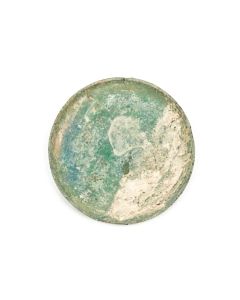 Roman mirror from Baalbek
Roman mirror from BaalbekThe bronze disc is the base plate of a bronze mirror, that was once attached to a handle and coated with a reflective metal layer. Typical for upper class Roman households during Imperial times.
Price: on request Ptolemaic sarcophagus mask
Ptolemaic sarcophagus maskImpressive wood relief of an idealized face. Remains of paint. The mask was part of a sarcophagus lid from Ancient Egypt during ptolemaic rule.
Price: on request Roman military whistle
Roman military whistleHistorically interesting example of Roman military equipment. Whistles of this type have been used in the 1st to 2nd cent. AD. Their function is not fully understood, yet.
Price: on request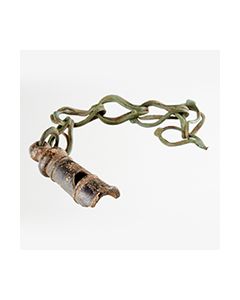 Roman military whistle
Roman military whistleHistorically interesting example of Roman military equipment. Whistles of this type have been used in the 1st to 2nd cent. AD. Their function is not fully understood, yet.
Price: on request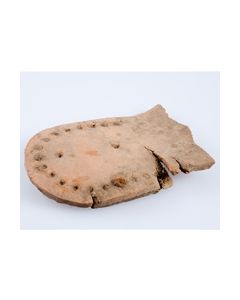 Fragment einer römischen Schuhsohle
Fragment einer römischen SchuhsohleHintere Hälfte einer römischen Schuhsohle. Seltenes Fundstück aus einem römischen Militärlager, von römischen Caligae, den typischen Militärsandalen der Legionäre.
Price: on request Paar römischer Würfel
Paar römischer WürfelZwei römische Würfel aus Bein, etwa 3. bis 4. Jhd.n.Chr., aus röm. Provinz Pannonia. Vermutlich Eigentum von Soldaten.
Price: on request Keltische Pferdeglocke
Keltische PferdeglockeCa. 300 v.Chr. Bis 200 v.Chr. Unter keltischer Besiedelung Galliens. Glocke aus Bronze, Pferdeglocke. 5cm lang.
Price: on request Paar römischer Würfel
Paar römischer WürfelZwei römische Würfel aus Bein, etwa 3. bis 4. Jhd.n.Chr., aus röm. Provinz Pannonia. Vermutlich Eigentum von Soldaten.
Price: on request Paar römischer Würfel
Paar römischer WürfelZwei römische Würfel aus Bein, etwa 3. bis 4. Jhd.n.Chr., aus röm. Provinz Pannonia. Vermutlich Eigentum von Soldaten.
Price: on request Römischer Würfel
Römischer WürfelEin römischer Würfel aus Bein, etwa 3. bis 4. Jhd.n.Chr., aus röm. Provinz Pannonia. Vermutlich Eigentum von Soldaten.
Price: on request

